Research Proposal: Improving Supervision in Domiciliary Care Services
VerifiedAdded on 2021/02/20
|9
|2393
|42
Project
AI Summary
This research proposal investigates methods to enhance supervision and its effectiveness within domiciliary care services. The introduction provides background on the importance of domiciliary care, the need for effective research, and the research aim, objectives, and questions. The study design outlines the research methodology, including qualitative and quantitative approaches, and details on data collection. The proposal covers study population, sampling methods, and ethical considerations. The research aims to improve supervision and make it more effective in domiciliary care services. The research design includes qualitative research, with a survey for data collection. The proposal also considers ethical aspects, such as voluntary participation and informed consent, ensuring the protection of participant privacy. The references section includes books and journals related to domiciliary care and related topics.

Domiciliary care,
Research Proposal
Research Proposal
Paraphrase This Document
Need a fresh take? Get an instant paraphrase of this document with our AI Paraphraser

Table of Contents
Title of the Research – “To improve supervision and make it more effective in Domiciliary care
services”. .........................................................................................................................................3
Introduction .....................................................................................................................................3
Background and statement of the research .....................................................................................3
Research Aim ..................................................................................................................................4
Research Objective..........................................................................................................................4
Research Question ..........................................................................................................................4
Study Design ...................................................................................................................................4
Study population and sampling .......................................................................................................7
Ethical considerations .....................................................................................................................8
REFERENCES ...............................................................................................................................9
Title of the Research – “To improve supervision and make it more effective in Domiciliary care
services”. .........................................................................................................................................3
Introduction .....................................................................................................................................3
Background and statement of the research .....................................................................................3
Research Aim ..................................................................................................................................4
Research Objective..........................................................................................................................4
Research Question ..........................................................................................................................4
Study Design ...................................................................................................................................4
Study population and sampling .......................................................................................................7
Ethical considerations .....................................................................................................................8
REFERENCES ...............................................................................................................................9

Title of the Research – “To improve supervision and make it more effective in
Domiciliary care services”.
Introduction
Domiciliary care services are services which are provided to people who live in their
homes and they need additional support for doing daily activities. This consists of various
household tasks, personal care and other activities that helps in managing quality of life. The
domicile care is given through a care taker or an individual who visits home and offer care to
people ( Kumamoto, Mizuno, and Washio, 2014). Some people keep fully trained care worker on
an hourly basis and these people help in arranging help for wide range of daily tasks which
consists of managing medication, personal and continence care, household tasks, meal
preparation, clinical care including caterer and stoma management and PEG feeding, help for
household activities, etc. A domiciliary care or home care is defined as the supportive care that
is provided to people who stay at home. This care can be provided by licensed healthcare
professionals. Domiciliary care agencies are present in society and these must follow some
procedures while recruiting care staff. The care providers must be given effective trainings for
ensuring that staff is delivering care effectively and safely. The domiciliary care service agencies
must ensure quality assurance checks through questionnaires, spot checks, training assessments,
complaints and compliments client forum. Domiciliary care services are provided to those people
who are suffering from chronic illness like heart failure, Alzheimer, respiratory failure etc. it is
important to have an effective domicile care takers.
Background and statement of the research
A domiciliary care service is an important part for developing the way by which patients
are treated. There is a need for conducting an effective research for determining the various ways
by which improvement in skills and work of domicile care can be achieved Chesterman, Davies,
and Judge, 2018). This research is conducted for analysing the way by which domicile care
takers can improve their operations. The main objective behind this project is that this research
will help in analysing the need of trainings and development sessions that can help in improving
the quality of service provided by domicile care workers.
Domiciliary care services”.
Introduction
Domiciliary care services are services which are provided to people who live in their
homes and they need additional support for doing daily activities. This consists of various
household tasks, personal care and other activities that helps in managing quality of life. The
domicile care is given through a care taker or an individual who visits home and offer care to
people ( Kumamoto, Mizuno, and Washio, 2014). Some people keep fully trained care worker on
an hourly basis and these people help in arranging help for wide range of daily tasks which
consists of managing medication, personal and continence care, household tasks, meal
preparation, clinical care including caterer and stoma management and PEG feeding, help for
household activities, etc. A domiciliary care or home care is defined as the supportive care that
is provided to people who stay at home. This care can be provided by licensed healthcare
professionals. Domiciliary care agencies are present in society and these must follow some
procedures while recruiting care staff. The care providers must be given effective trainings for
ensuring that staff is delivering care effectively and safely. The domiciliary care service agencies
must ensure quality assurance checks through questionnaires, spot checks, training assessments,
complaints and compliments client forum. Domiciliary care services are provided to those people
who are suffering from chronic illness like heart failure, Alzheimer, respiratory failure etc. it is
important to have an effective domicile care takers.
Background and statement of the research
A domiciliary care service is an important part for developing the way by which patients
are treated. There is a need for conducting an effective research for determining the various ways
by which improvement in skills and work of domicile care can be achieved Chesterman, Davies,
and Judge, 2018). This research is conducted for analysing the way by which domicile care
takers can improve their operations. The main objective behind this project is that this research
will help in analysing the need of trainings and development sessions that can help in improving
the quality of service provided by domicile care workers.
⊘ This is a preview!⊘
Do you want full access?
Subscribe today to unlock all pages.

Trusted by 1+ million students worldwide
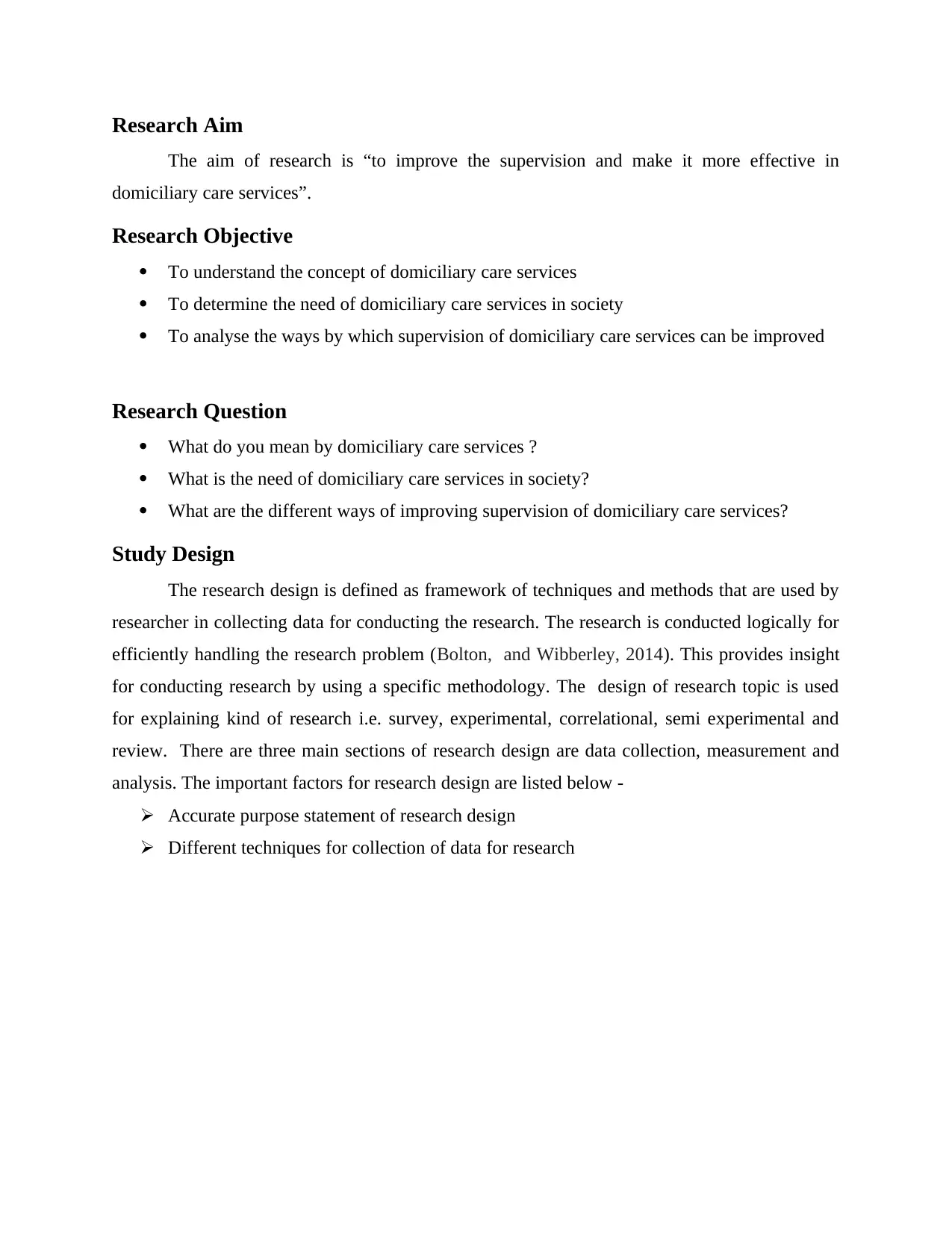
Research Aim
The aim of research is “to improve the supervision and make it more effective in
domiciliary care services”.
Research Objective
To understand the concept of domiciliary care services
To determine the need of domiciliary care services in society
To analyse the ways by which supervision of domiciliary care services can be improved
Research Question
What do you mean by domiciliary care services ?
What is the need of domiciliary care services in society?
What are the different ways of improving supervision of domiciliary care services?
Study Design
The research design is defined as framework of techniques and methods that are used by
researcher in collecting data for conducting the research. The research is conducted logically for
efficiently handling the research problem (Bolton, and Wibberley, 2014). This provides insight
for conducting research by using a specific methodology. The design of research topic is used
for explaining kind of research i.e. survey, experimental, correlational, semi experimental and
review. There are three main sections of research design are data collection, measurement and
analysis. The important factors for research design are listed below -
Accurate purpose statement of research design
Different techniques for collection of data for research
The aim of research is “to improve the supervision and make it more effective in
domiciliary care services”.
Research Objective
To understand the concept of domiciliary care services
To determine the need of domiciliary care services in society
To analyse the ways by which supervision of domiciliary care services can be improved
Research Question
What do you mean by domiciliary care services ?
What is the need of domiciliary care services in society?
What are the different ways of improving supervision of domiciliary care services?
Study Design
The research design is defined as framework of techniques and methods that are used by
researcher in collecting data for conducting the research. The research is conducted logically for
efficiently handling the research problem (Bolton, and Wibberley, 2014). This provides insight
for conducting research by using a specific methodology. The design of research topic is used
for explaining kind of research i.e. survey, experimental, correlational, semi experimental and
review. There are three main sections of research design are data collection, measurement and
analysis. The important factors for research design are listed below -
Accurate purpose statement of research design
Different techniques for collection of data for research
Paraphrase This Document
Need a fresh take? Get an instant paraphrase of this document with our AI Paraphraser
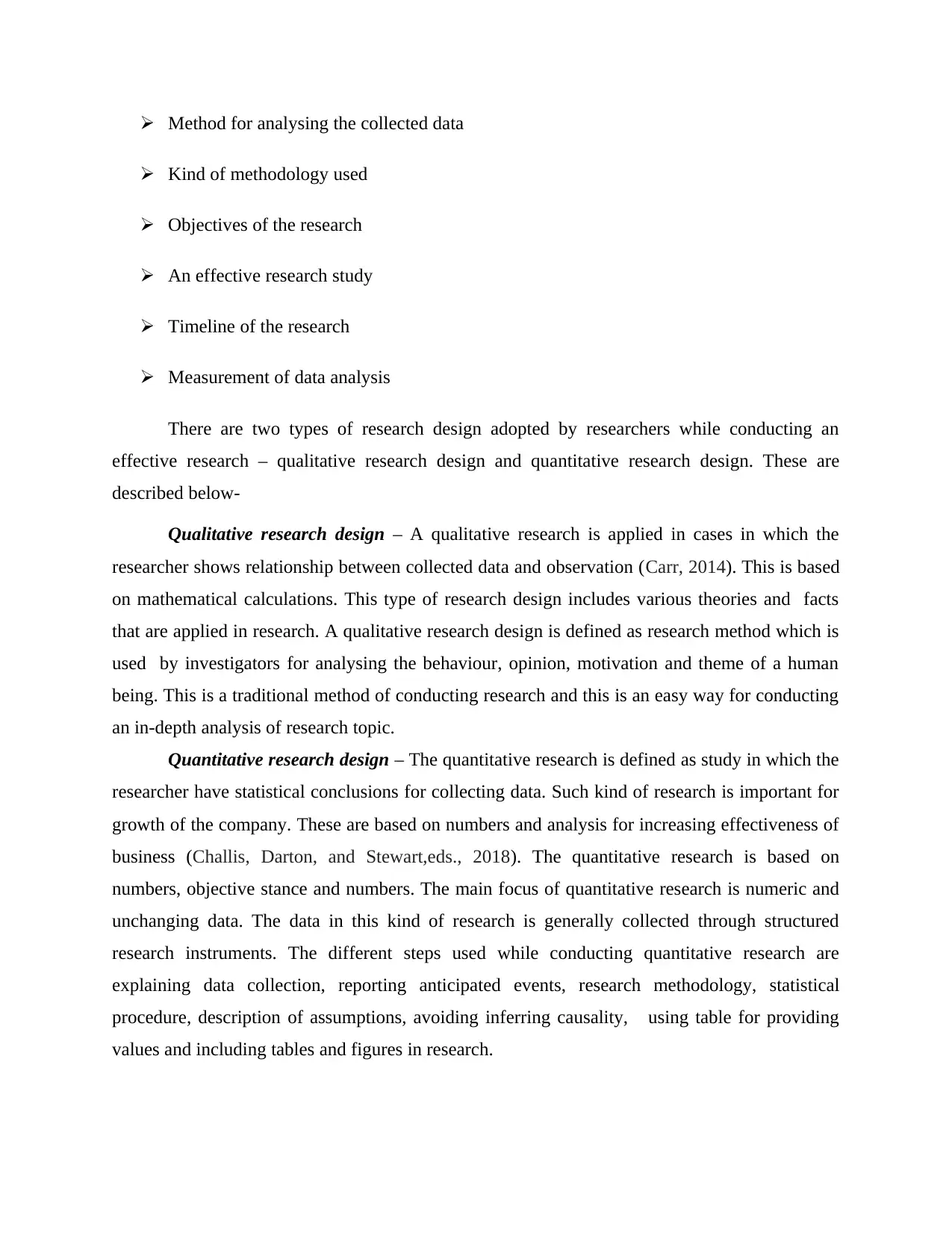
Method for analysing the collected data
Kind of methodology used
Objectives of the research
An effective research study
Timeline of the research
Measurement of data analysis
There are two types of research design adopted by researchers while conducting an
effective research – qualitative research design and quantitative research design. These are
described below-
Qualitative research design – A qualitative research is applied in cases in which the
researcher shows relationship between collected data and observation (Carr, 2014). This is based
on mathematical calculations. This type of research design includes various theories and facts
that are applied in research. A qualitative research design is defined as research method which is
used by investigators for analysing the behaviour, opinion, motivation and theme of a human
being. This is a traditional method of conducting research and this is an easy way for conducting
an in-depth analysis of research topic.
Quantitative research design – The quantitative research is defined as study in which the
researcher have statistical conclusions for collecting data. Such kind of research is important for
growth of the company. These are based on numbers and analysis for increasing effectiveness of
business (Challis, Darton, and Stewart,eds., 2018). The quantitative research is based on
numbers, objective stance and numbers. The main focus of quantitative research is numeric and
unchanging data. The data in this kind of research is generally collected through structured
research instruments. The different steps used while conducting quantitative research are
explaining data collection, reporting anticipated events, research methodology, statistical
procedure, description of assumptions, avoiding inferring causality, using table for providing
values and including tables and figures in research.
Kind of methodology used
Objectives of the research
An effective research study
Timeline of the research
Measurement of data analysis
There are two types of research design adopted by researchers while conducting an
effective research – qualitative research design and quantitative research design. These are
described below-
Qualitative research design – A qualitative research is applied in cases in which the
researcher shows relationship between collected data and observation (Carr, 2014). This is based
on mathematical calculations. This type of research design includes various theories and facts
that are applied in research. A qualitative research design is defined as research method which is
used by investigators for analysing the behaviour, opinion, motivation and theme of a human
being. This is a traditional method of conducting research and this is an easy way for conducting
an in-depth analysis of research topic.
Quantitative research design – The quantitative research is defined as study in which the
researcher have statistical conclusions for collecting data. Such kind of research is important for
growth of the company. These are based on numbers and analysis for increasing effectiveness of
business (Challis, Darton, and Stewart,eds., 2018). The quantitative research is based on
numbers, objective stance and numbers. The main focus of quantitative research is numeric and
unchanging data. The data in this kind of research is generally collected through structured
research instruments. The different steps used while conducting quantitative research are
explaining data collection, reporting anticipated events, research methodology, statistical
procedure, description of assumptions, avoiding inferring causality, using table for providing
values and including tables and figures in research.
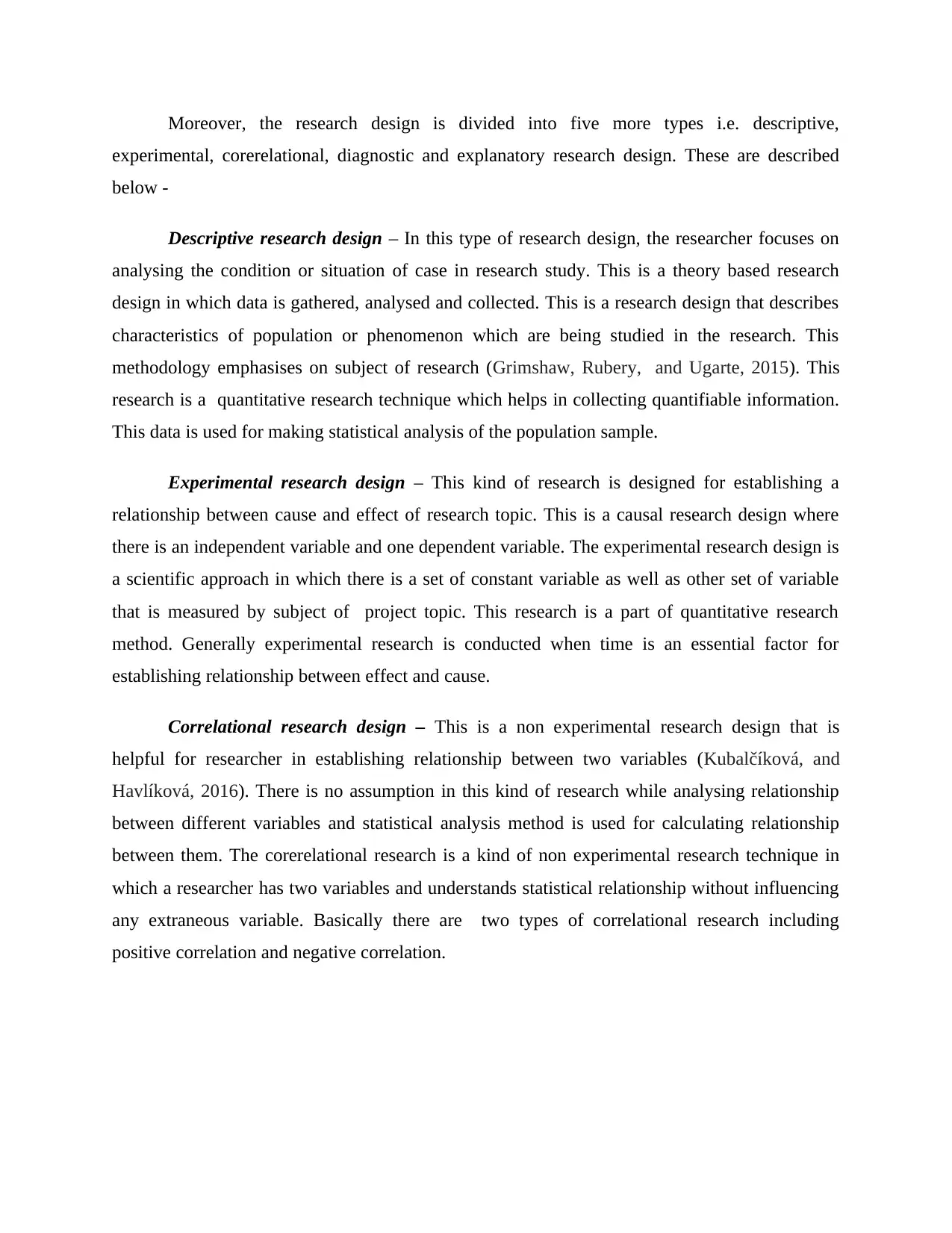
Moreover, the research design is divided into five more types i.e. descriptive,
experimental, corerelational, diagnostic and explanatory research design. These are described
below -
Descriptive research design – In this type of research design, the researcher focuses on
analysing the condition or situation of case in research study. This is a theory based research
design in which data is gathered, analysed and collected. This is a research design that describes
characteristics of population or phenomenon which are being studied in the research. This
methodology emphasises on subject of research (Grimshaw, Rubery, and Ugarte, 2015). This
research is a quantitative research technique which helps in collecting quantifiable information.
This data is used for making statistical analysis of the population sample.
Experimental research design – This kind of research is designed for establishing a
relationship between cause and effect of research topic. This is a causal research design where
there is an independent variable and one dependent variable. The experimental research design is
a scientific approach in which there is a set of constant variable as well as other set of variable
that is measured by subject of project topic. This research is a part of quantitative research
method. Generally experimental research is conducted when time is an essential factor for
establishing relationship between effect and cause.
Correlational research design – This is a non experimental research design that is
helpful for researcher in establishing relationship between two variables (Kubalčíková, and
Havlíková, 2016). There is no assumption in this kind of research while analysing relationship
between different variables and statistical analysis method is used for calculating relationship
between them. The corerelational research is a kind of non experimental research technique in
which a researcher has two variables and understands statistical relationship without influencing
any extraneous variable. Basically there are two types of correlational research including
positive correlation and negative correlation.
experimental, corerelational, diagnostic and explanatory research design. These are described
below -
Descriptive research design – In this type of research design, the researcher focuses on
analysing the condition or situation of case in research study. This is a theory based research
design in which data is gathered, analysed and collected. This is a research design that describes
characteristics of population or phenomenon which are being studied in the research. This
methodology emphasises on subject of research (Grimshaw, Rubery, and Ugarte, 2015). This
research is a quantitative research technique which helps in collecting quantifiable information.
This data is used for making statistical analysis of the population sample.
Experimental research design – This kind of research is designed for establishing a
relationship between cause and effect of research topic. This is a causal research design where
there is an independent variable and one dependent variable. The experimental research design is
a scientific approach in which there is a set of constant variable as well as other set of variable
that is measured by subject of project topic. This research is a part of quantitative research
method. Generally experimental research is conducted when time is an essential factor for
establishing relationship between effect and cause.
Correlational research design – This is a non experimental research design that is
helpful for researcher in establishing relationship between two variables (Kubalčíková, and
Havlíková, 2016). There is no assumption in this kind of research while analysing relationship
between different variables and statistical analysis method is used for calculating relationship
between them. The corerelational research is a kind of non experimental research technique in
which a researcher has two variables and understands statistical relationship without influencing
any extraneous variable. Basically there are two types of correlational research including
positive correlation and negative correlation.
⊘ This is a preview!⊘
Do you want full access?
Subscribe today to unlock all pages.

Trusted by 1+ million students worldwide
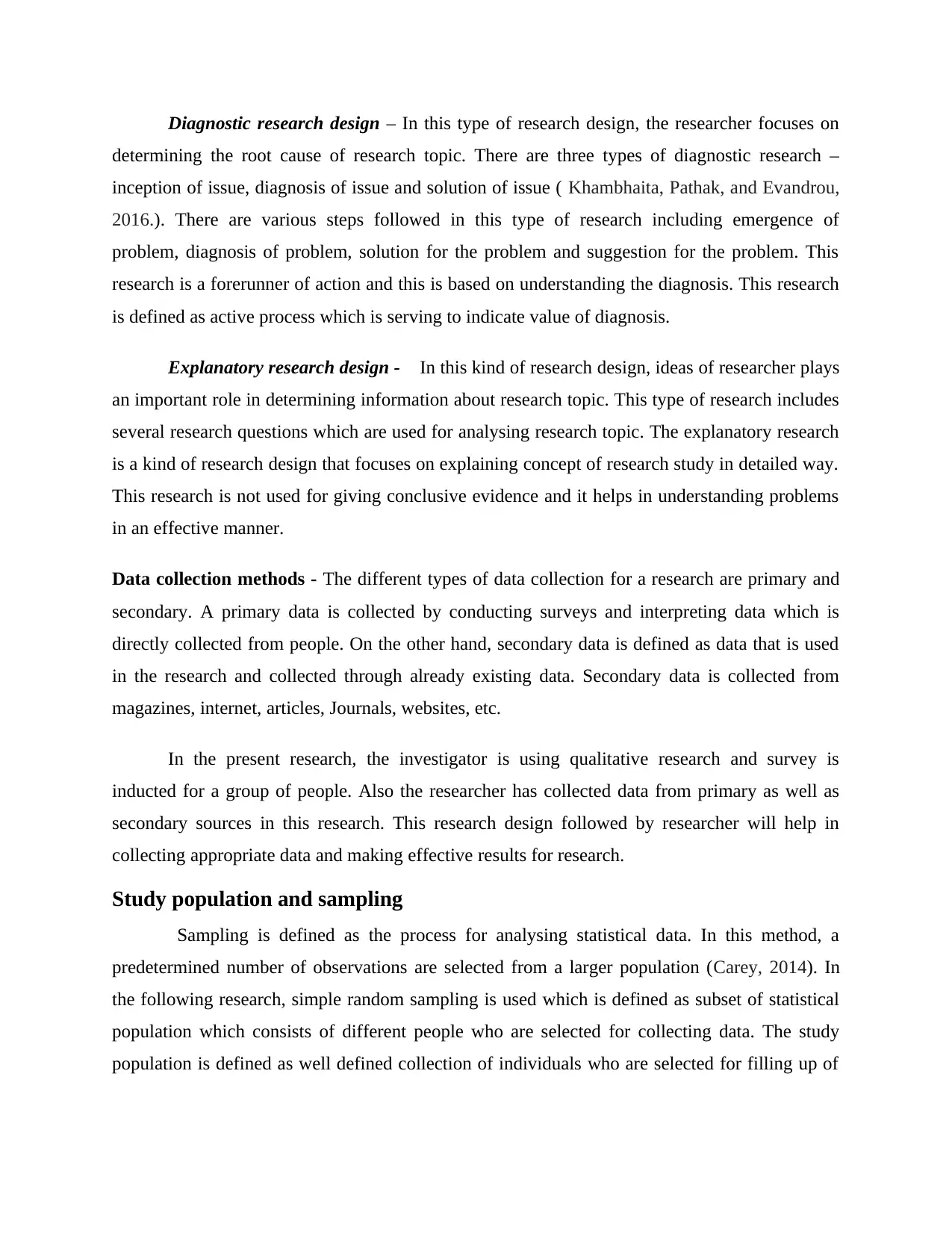
Diagnostic research design – In this type of research design, the researcher focuses on
determining the root cause of research topic. There are three types of diagnostic research –
inception of issue, diagnosis of issue and solution of issue ( Khambhaita, Pathak, and Evandrou,
2016.). There are various steps followed in this type of research including emergence of
problem, diagnosis of problem, solution for the problem and suggestion for the problem. This
research is a forerunner of action and this is based on understanding the diagnosis. This research
is defined as active process which is serving to indicate value of diagnosis.
Explanatory research design - In this kind of research design, ideas of researcher plays
an important role in determining information about research topic. This type of research includes
several research questions which are used for analysing research topic. The explanatory research
is a kind of research design that focuses on explaining concept of research study in detailed way.
This research is not used for giving conclusive evidence and it helps in understanding problems
in an effective manner.
Data collection methods - The different types of data collection for a research are primary and
secondary. A primary data is collected by conducting surveys and interpreting data which is
directly collected from people. On the other hand, secondary data is defined as data that is used
in the research and collected through already existing data. Secondary data is collected from
magazines, internet, articles, Journals, websites, etc.
In the present research, the investigator is using qualitative research and survey is
inducted for a group of people. Also the researcher has collected data from primary as well as
secondary sources in this research. This research design followed by researcher will help in
collecting appropriate data and making effective results for research.
Study population and sampling
Sampling is defined as the process for analysing statistical data. In this method, a
predetermined number of observations are selected from a larger population (Carey, 2014). In
the following research, simple random sampling is used which is defined as subset of statistical
population which consists of different people who are selected for collecting data. The study
population is defined as well defined collection of individuals who are selected for filling up of
determining the root cause of research topic. There are three types of diagnostic research –
inception of issue, diagnosis of issue and solution of issue ( Khambhaita, Pathak, and Evandrou,
2016.). There are various steps followed in this type of research including emergence of
problem, diagnosis of problem, solution for the problem and suggestion for the problem. This
research is a forerunner of action and this is based on understanding the diagnosis. This research
is defined as active process which is serving to indicate value of diagnosis.
Explanatory research design - In this kind of research design, ideas of researcher plays
an important role in determining information about research topic. This type of research includes
several research questions which are used for analysing research topic. The explanatory research
is a kind of research design that focuses on explaining concept of research study in detailed way.
This research is not used for giving conclusive evidence and it helps in understanding problems
in an effective manner.
Data collection methods - The different types of data collection for a research are primary and
secondary. A primary data is collected by conducting surveys and interpreting data which is
directly collected from people. On the other hand, secondary data is defined as data that is used
in the research and collected through already existing data. Secondary data is collected from
magazines, internet, articles, Journals, websites, etc.
In the present research, the investigator is using qualitative research and survey is
inducted for a group of people. Also the researcher has collected data from primary as well as
secondary sources in this research. This research design followed by researcher will help in
collecting appropriate data and making effective results for research.
Study population and sampling
Sampling is defined as the process for analysing statistical data. In this method, a
predetermined number of observations are selected from a larger population (Carey, 2014). In
the following research, simple random sampling is used which is defined as subset of statistical
population which consists of different people who are selected for collecting data. The study
population is defined as well defined collection of individuals who are selected for filling up of
Paraphrase This Document
Need a fresh take? Get an instant paraphrase of this document with our AI Paraphraser
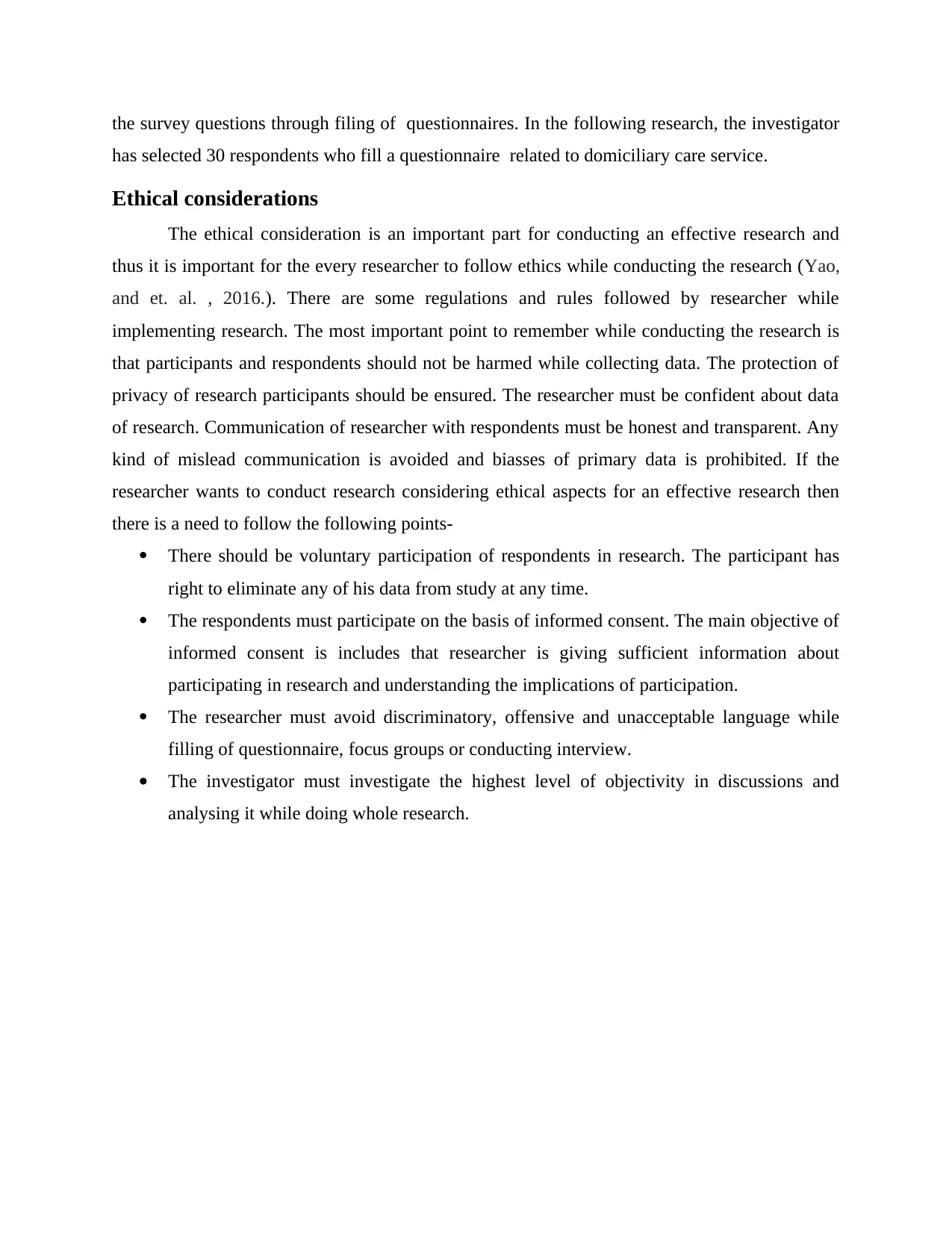
the survey questions through filing of questionnaires. In the following research, the investigator
has selected 30 respondents who fill a questionnaire related to domiciliary care service.
Ethical considerations
The ethical consideration is an important part for conducting an effective research and
thus it is important for the every researcher to follow ethics while conducting the research (Yao,
and et. al. , 2016.). There are some regulations and rules followed by researcher while
implementing research. The most important point to remember while conducting the research is
that participants and respondents should not be harmed while collecting data. The protection of
privacy of research participants should be ensured. The researcher must be confident about data
of research. Communication of researcher with respondents must be honest and transparent. Any
kind of mislead communication is avoided and biasses of primary data is prohibited. If the
researcher wants to conduct research considering ethical aspects for an effective research then
there is a need to follow the following points-
There should be voluntary participation of respondents in research. The participant has
right to eliminate any of his data from study at any time.
The respondents must participate on the basis of informed consent. The main objective of
informed consent is includes that researcher is giving sufficient information about
participating in research and understanding the implications of participation.
The researcher must avoid discriminatory, offensive and unacceptable language while
filling of questionnaire, focus groups or conducting interview.
The investigator must investigate the highest level of objectivity in discussions and
analysing it while doing whole research.
has selected 30 respondents who fill a questionnaire related to domiciliary care service.
Ethical considerations
The ethical consideration is an important part for conducting an effective research and
thus it is important for the every researcher to follow ethics while conducting the research (Yao,
and et. al. , 2016.). There are some regulations and rules followed by researcher while
implementing research. The most important point to remember while conducting the research is
that participants and respondents should not be harmed while collecting data. The protection of
privacy of research participants should be ensured. The researcher must be confident about data
of research. Communication of researcher with respondents must be honest and transparent. Any
kind of mislead communication is avoided and biasses of primary data is prohibited. If the
researcher wants to conduct research considering ethical aspects for an effective research then
there is a need to follow the following points-
There should be voluntary participation of respondents in research. The participant has
right to eliminate any of his data from study at any time.
The respondents must participate on the basis of informed consent. The main objective of
informed consent is includes that researcher is giving sufficient information about
participating in research and understanding the implications of participation.
The researcher must avoid discriminatory, offensive and unacceptable language while
filling of questionnaire, focus groups or conducting interview.
The investigator must investigate the highest level of objectivity in discussions and
analysing it while doing whole research.
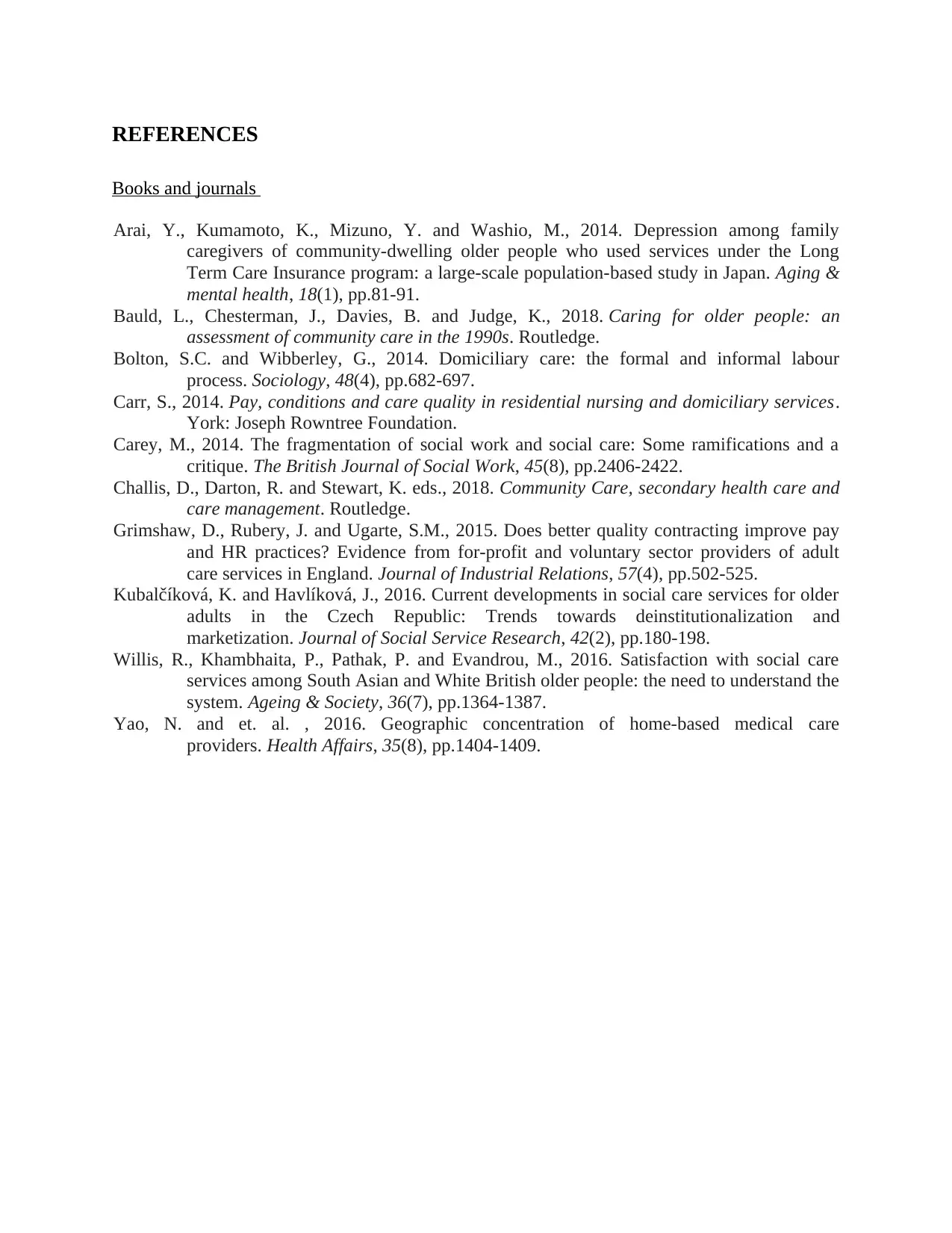
REFERENCES
Books and journals
Arai, Y., Kumamoto, K., Mizuno, Y. and Washio, M., 2014. Depression among family
caregivers of community-dwelling older people who used services under the Long
Term Care Insurance program: a large-scale population-based study in Japan. Aging &
mental health, 18(1), pp.81-91.
Bauld, L., Chesterman, J., Davies, B. and Judge, K., 2018. Caring for older people: an
assessment of community care in the 1990s. Routledge.
Bolton, S.C. and Wibberley, G., 2014. Domiciliary care: the formal and informal labour
process. Sociology, 48(4), pp.682-697.
Carr, S., 2014. Pay, conditions and care quality in residential nursing and domiciliary services.
York: Joseph Rowntree Foundation.
Carey, M., 2014. The fragmentation of social work and social care: Some ramifications and a
critique. The British Journal of Social Work, 45(8), pp.2406-2422.
Challis, D., Darton, R. and Stewart, K. eds., 2018. Community Care, secondary health care and
care management. Routledge.
Grimshaw, D., Rubery, J. and Ugarte, S.M., 2015. Does better quality contracting improve pay
and HR practices? Evidence from for-profit and voluntary sector providers of adult
care services in England. Journal of Industrial Relations, 57(4), pp.502-525.
Kubalčíková, K. and Havlíková, J., 2016. Current developments in social care services for older
adults in the Czech Republic: Trends towards deinstitutionalization and
marketization. Journal of Social Service Research, 42(2), pp.180-198.
Willis, R., Khambhaita, P., Pathak, P. and Evandrou, M., 2016. Satisfaction with social care
services among South Asian and White British older people: the need to understand the
system. Ageing & Society, 36(7), pp.1364-1387.
Yao, N. and et. al. , 2016. Geographic concentration of home-based medical care
providers. Health Affairs, 35(8), pp.1404-1409.
Books and journals
Arai, Y., Kumamoto, K., Mizuno, Y. and Washio, M., 2014. Depression among family
caregivers of community-dwelling older people who used services under the Long
Term Care Insurance program: a large-scale population-based study in Japan. Aging &
mental health, 18(1), pp.81-91.
Bauld, L., Chesterman, J., Davies, B. and Judge, K., 2018. Caring for older people: an
assessment of community care in the 1990s. Routledge.
Bolton, S.C. and Wibberley, G., 2014. Domiciliary care: the formal and informal labour
process. Sociology, 48(4), pp.682-697.
Carr, S., 2014. Pay, conditions and care quality in residential nursing and domiciliary services.
York: Joseph Rowntree Foundation.
Carey, M., 2014. The fragmentation of social work and social care: Some ramifications and a
critique. The British Journal of Social Work, 45(8), pp.2406-2422.
Challis, D., Darton, R. and Stewart, K. eds., 2018. Community Care, secondary health care and
care management. Routledge.
Grimshaw, D., Rubery, J. and Ugarte, S.M., 2015. Does better quality contracting improve pay
and HR practices? Evidence from for-profit and voluntary sector providers of adult
care services in England. Journal of Industrial Relations, 57(4), pp.502-525.
Kubalčíková, K. and Havlíková, J., 2016. Current developments in social care services for older
adults in the Czech Republic: Trends towards deinstitutionalization and
marketization. Journal of Social Service Research, 42(2), pp.180-198.
Willis, R., Khambhaita, P., Pathak, P. and Evandrou, M., 2016. Satisfaction with social care
services among South Asian and White British older people: the need to understand the
system. Ageing & Society, 36(7), pp.1364-1387.
Yao, N. and et. al. , 2016. Geographic concentration of home-based medical care
providers. Health Affairs, 35(8), pp.1404-1409.
⊘ This is a preview!⊘
Do you want full access?
Subscribe today to unlock all pages.

Trusted by 1+ million students worldwide
1 out of 9
Related Documents
Your All-in-One AI-Powered Toolkit for Academic Success.
+13062052269
info@desklib.com
Available 24*7 on WhatsApp / Email
![[object Object]](/_next/static/media/star-bottom.7253800d.svg)
Unlock your academic potential
Copyright © 2020–2025 A2Z Services. All Rights Reserved. Developed and managed by ZUCOL.





